How Visual Practitioners Listen for Diversity: tips from the field (long form)

As a graphic recorder or facilitator, how do you “Listen for Diversity”? Many of us are working in specialized fields and it’s not one size fits all. Now for the first time, you can read expert advice from over 20 visual practitioners.
This month, I hosted a session called Listening for Diversity at the 2017 International Forum of Visual Practitioners conference. As visual practice expands, it’s an exciting time for us to share techniques about “Listening for Diversity” that work for practitioners, clients, and communities.
I wanted the workshop to include as many voices as possible – including people who aren’t able to make this year’s conference, and to amplify what’s working for practitioners. So before the workshop, I reached out to the graphic recording community for insights.
The responses are grouped by five themes:
- self-reflection and diversity
- drawing diversity
- diversity of perspectives
- relationships, and
- graphic recording as a participatory process.
Diversity comes in infinite forms — race, gender, cultures, age, and abilities to just name a few. As visual practitioners, it’s a great time to start a conversation.
Images were scribed/graphic recorded by participants of the Listening for Diversity workshop session unless otherwise noted.
Enjoy!
1. Self-reflection
As many graphic recorders noted, listening for diversity isn’t just about the people in the room, it’s about what we bring to the room – that is, we need to question our own biases and assumptions, and even how we conceive of our role. As Anthony queries, is it just about creating a visual record of events or about intervening? Having our peers record our work could also enable us to step back and look at our facilitation through someone else’s eyes. Only through critical self-reflection, will we be better equipped to listen for diversity.

In order to represent diversity in ways that advance it, create change, equity & inclusion, we ourselves need to be able to see what we are not seeing… We must question our assumptions and seek to understand what things mean to others, what made them so, and what is really their impact as visual practitioners … We all know that it’s hard to understand what we can’t see and our gift is to help folks see. – Claudia Lopez
When I worked with communities in Vancouver’s Downtown East Side on a potential redevelopment of the Woodward’s Building (which was then occupied by squatters), we engaged with many people marginalized by homelessness, poverty, addictions, and/or mental illness. In facilitation, we sought to respect their passions, their own vision for a better future, and to meet them where they were (literally and \). Checking my own preconceptions, attitudes and biases was vital for me to be open and credible- they had to trust me enough to share their (often very private) aspirations so that I could capture their ideas visually. – Drew Ferrari
Is there a better way for everyone to be heard? I think it’s a really good idea for us to have our own conversations drawn by someone else. – Aaron Johannes

How we present images on a page says everything about who WE are, how we see the world, and how we instantiate the biases, dominant points of view, and commonly-held reference points in our work. It’s a subjective business–and our subjectivity is both our Achilles heel as well as our calling card. It all depends on how we interrogate it, play with it, and use it to help groups and teams see their conversation. My suggestions are not prescriptive, but rather, borne out of inquiry. Do we have a role in “signal boosting” voices that are not usually heard? Do we have a role in saying directly to groups: “These are the voices I’m hearing…but what other voices need to be heard here?” What might we offer by embracing the role of “artist” and see the world differently, in contrast to the time-honored tradition of “capturing” only what is heard? – Anthony Weeks
2. Visualizing diversity
One of the surprising outcomes of the survey, was the number of excellent and thoughtful techniques about how to visualize or draw diversity! Given the nature of our work, it makes sense that we are also translators or interpreters – we put on paper what we hear. So, it’s important to consider how we put diversity to paper.
Drawing diversity is a prickly, tricky subject for some recorders…I try to go for a light touch. It’s entirely possible to draw diverse people by making slight changes in the shapes of faces, noses, eyes and clothing. I try to avoid drawing “costumes” if that’s not what people wear in everyday life. I’ve also done a trick where I draw the country flag or country flag colors in the body of the person to show German or Chinese or French people. I think it’s good to be conscious of your visual biases when you draw.– Deb Aoki
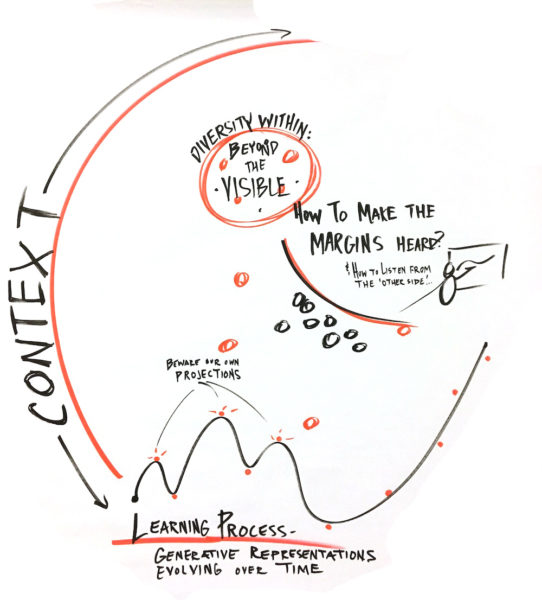 When dealing with diversity issues, sometimes it’s best to put the pen into the group’s hands. Let them reflect on issues through facilitated exercises, drawing exercises, templates, etc. We’re only one person in the room. Sometimes it’s more powerful to let someone else draw. – Sophia Liang
When dealing with diversity issues, sometimes it’s best to put the pen into the group’s hands. Let them reflect on issues through facilitated exercises, drawing exercises, templates, etc. We’re only one person in the room. Sometimes it’s more powerful to let someone else draw. – Sophia Liang
To visualize diversity in a meeting, I ask participants to describe attributes of a successfully diverse team that they have served on or participated in. I draw a group of diverse people on a flip chart and add the words they offer up. I refer to this diversity chart throughout the course of the meeting. – Heather Martinez
We always introduce ourselves as visual practitioners and tell people it is very important to us that we get the images and words correct, then we show them our ‘delete key’ or ‘chart Band-Aids (large silver backed labels) so we can change anything on the chart, so please tell us if we have got anything wrong so we can correct it! – Rob Benn
I ask the participants to come to me during the breaks and tell me what they feel should be added. I also do couple of speech bubbles to note down different points of view. I note down also fun moments/random comments – this works amazingly well for the participants to feel connected to the recording. I also try to create a complex picture that makes sense as a whole (e.g. road to somewhere, a scene, a street in the city with different buildings around), but it always has to be connected with what is being spoken about. – Bea Broskova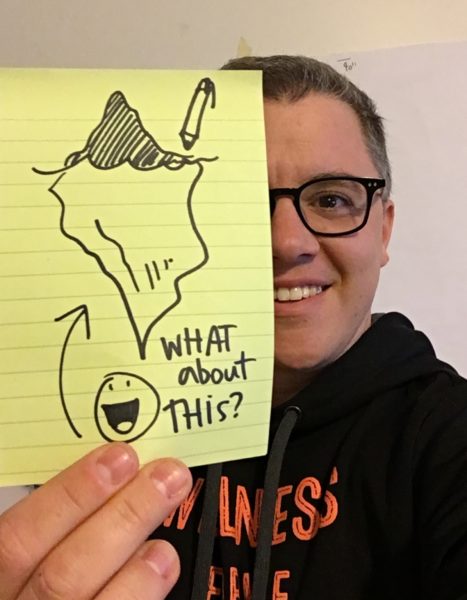
I want to reflect the people in the room, so I try to look at the actual people present, and draw who I see. It has also helped me to study photos online of different ethnic groups, to practice learning ways to draw different types of people quickly, but in a manner that is (I hope) respectful. When I introduce myself, I let people know anything I write or draw can be changed. I encourage people to let me know if they feel mis-heard or mis-represented by anything on the chart, and to tell me in the moment or on a break and I will change it. – Emily Shepard
One big AHA moment I’ve had is to acknowledge the “white space”…the space where people didn’t have ideas, or realized more thought was needed. One particular event comes to mind. At the end of one session, there was the dreaded “vacuum of white space” that I didn’t know how to fill. The truth was that the group didn’t have as many ideas of HOW to execute their vision as they did on WHAT was their vision. So I put dashed lines around it, and labelled it “more discussion needed on how to build the archive”. It was actually really effective, especially when compared to other graphics of the day, which were full of diverse ideas and concepts. – Yolanda Liman
Let’s spread and integrate new terms in our visual vocabulary: symbols for different ways of reduced mobility, gender, colour… – KSt
3. Diversity as inclusion and visibility
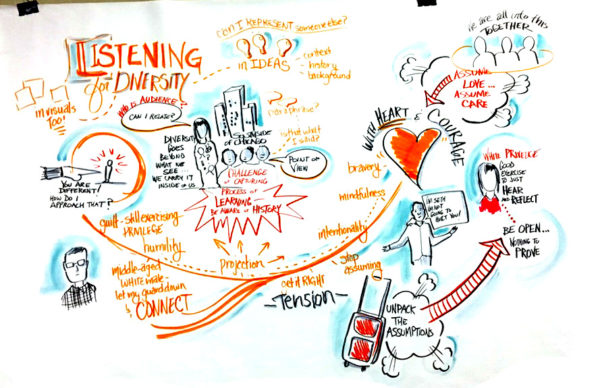 Another theme that emerged in the survey was the idea of inclusion and visibility. As graphic recorders, how do we listen for diversity when the visual cues that we might rely on to “signal” diversity, isn’t visible? How do we ensure that we reflect all kinds of diversity? This might also be thought of within the context of systems of support within a particular community, as noted by Fran O’Hara. Diversity might extend beyond the people in the room, and include those who work alongside them.
Another theme that emerged in the survey was the idea of inclusion and visibility. As graphic recorders, how do we listen for diversity when the visual cues that we might rely on to “signal” diversity, isn’t visible? How do we ensure that we reflect all kinds of diversity? This might also be thought of within the context of systems of support within a particular community, as noted by Fran O’Hara. Diversity might extend beyond the people in the room, and include those who work alongside them.
I scan the room looking for cues, but so many of them are not visible initially. I am thinking particularly about non-visible disabilities such as deafness or autism. I should also say I’m very anxious about representing various groups (especially racial) since I don’t want to stereotype or ‘get it wrong’ — which is something I’m working to overcome. – Alison
We have done a lot of work with people with dementia, representing their voices and actual words on the map is so important, to change perceptions. Their carers too as they are often invisible. – Fran O’Hara
4. Diversity of perspectives
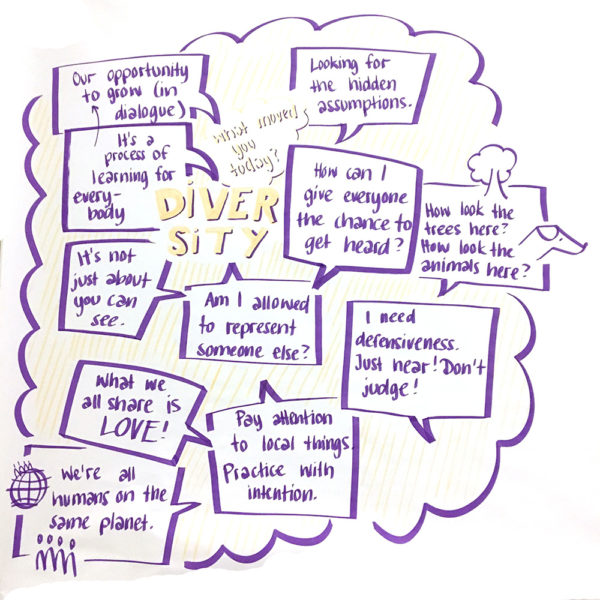 Listening for diversity also speaks to the need for cultivating and inviting a diversity of perspectives in our sessions. Sometimes this means pushing ourselves and others to get out of our comfort zones and to think about an issue from another standpoint.
Listening for diversity also speaks to the need for cultivating and inviting a diversity of perspectives in our sessions. Sometimes this means pushing ourselves and others to get out of our comfort zones and to think about an issue from another standpoint.
Diversity is also about differences of ideas and perspectives. Sam Kaner’s approach to “balancing” ideas (which is, including and encouraging diversity of opinions) is a way to show diversity on the chart. – Brian Tarallo
I aim to be as neutral as possible when I’m listening to a discussion…. Participants need to see a diversity of perspectives in order to work through challenges and find solutions. There is also immense power in metaphor and pushing a group to think about their work in a new context. For example, choosing to use unique metaphors (even if the client is speaking in clichés), subtly helps to open the group’s mind to new ways of thinking about a topic… especially if they’ve only ever thought about it in one way. Or framing a strategic planning session around a theme or larger metaphor can help participants step outside their usual pattern of thinking, which in turn allows people to better hear and understand their peers. – Tanya Gadsby
5. Relationships
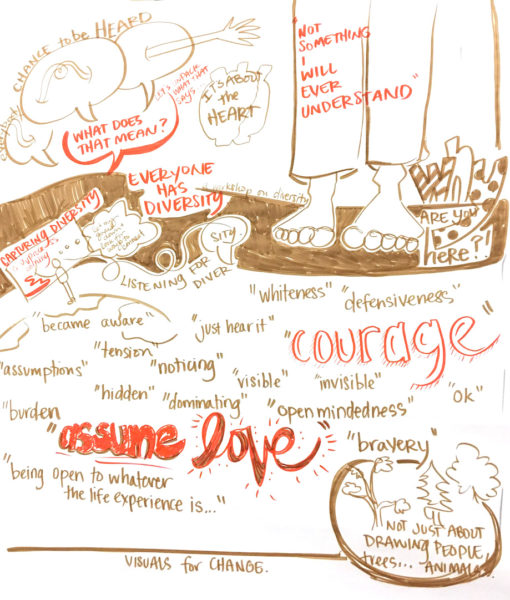 Many visual facilitators stressed the importance of building relationships with clients and the community before and during a meeting. Beginning a dialogue beforehand sets a tone of respect and trust, and is the perfect opportunity to get clarity on expectations, and insight into how diversity fits into the event. This also encourages the client/community to be proactive and have a more interactive role in the process, especially if seeking feedback along the way. Building relationships as Aaron and Liz have done, demonstrates the impact that graphic recording can have on the community-at-large.
Many visual facilitators stressed the importance of building relationships with clients and the community before and during a meeting. Beginning a dialogue beforehand sets a tone of respect and trust, and is the perfect opportunity to get clarity on expectations, and insight into how diversity fits into the event. This also encourages the client/community to be proactive and have a more interactive role in the process, especially if seeking feedback along the way. Building relationships as Aaron and Liz have done, demonstrates the impact that graphic recording can have on the community-at-large.
I’m a First Nations woman and visualizing diversity within First Nation groups includes listening to people to find key images that express the cultural backbone of each specific cultural group. Engagement throughout the graphic recording process is the best way to empower each group!
I research the nation before I work with them in order to learn about their specific cultural practices. This may include speaking with people who are from the nation or looking at their websites, newsletters, blogs and other social media. – Michelle Buchholz, with Drawing Change
When I am given the honour of capturing a sensitive conversation or a cherished teaching in an Indigenous community, and if I sense that there is discomfort around having a written document (as so often the written word has been used against people), I often ask to have an Elder or someone else who is willing sit with me and just give me the nod or the head shake or even work more interactively with me and I will draw in pencil so that we both know we can experiment or play and then erase if we don’t like it. – Colleen Stevenson

Liz and I did a “draw-a-thon” to raise money for a book club for people with disabilities. At one point I was drawing serious books on a shelf and suddenly realized that she was drawing Spiderman swinging off of the shelf – so much fun and it attracted people into the drawing. This has turned into some work around emergent literacy and how graphic recording can support marginalised people to learn to read and write. Two years later we are graphically recording a think-tank of librarians, educators and services to think about leveraging literacy for adults with disabilities. I think connecting graphic recorders and educators is such a great idea. – Aaron Johannes and Liz Etmanski
I’ve found that the most helpful tip is not about a particular tactic or drawing technique – it’s about relationships. If I can build trust with the event organizers and participants before I start drawing anything, I’ll feel confident in trusting my own judgment about the right thing to do. And if I’m unsure, I’ll feel comfortable asking them for guidance, even right in the middle of the event. – Sam Hester
6. How to practice listening

Listening for diversity is also a skill that we must practice, and some of the respondents shared their tips for being a better listener. We can’t support diversity in our work without cultivating this crucial skill. Indeed, as one respondent noted, our field has a lot to offer beyond what happens in the recording session – we have the ability to share our understanding with a broader audience. Listening for diversity is something that can be taught to many folks, so let’s be ambitious!
- Listen for the level of social, economic or political/capital a group has or does not have or the barriers or gateways to that.
2. Listen for the level of risk to self or social, economic, or political capital.
3. Listen for levels of collaboration vs consensus. Often the dominant culture of communication will inadvertently exclude a group. A consensus is time-consuming.
4. The concept of inclusion, exclusion, or integration might be confusing for some or appropriated by others.
5. What voices are not there often as a result of number 1.
6. Listen to discussion (often participation) dialogue (people stating their idea) vs discourse (knowledge & community building). – Bonnie Jeansonne
 Shift[ing] my own frame of mind in order to listen is a conscious decision and effort, [as is] listening without judgment. Have the courage to ask what / how to draw something that is representative of a particular community. – Rosanna von Sacken
Shift[ing] my own frame of mind in order to listen is a conscious decision and effort, [as is] listening without judgment. Have the courage to ask what / how to draw something that is representative of a particular community. – Rosanna von Sacken
- Be a lifelong story listener. When you meet people, listen to their story.
- When communicating diversity, do a reality check. Who are real people you have met and communicate their diversity.
- Blast stereotypes. Acknowledge their function as the top of the iceberg, but dive deeper into the nuances of people’s actual experiences/lives. – Ana Vargas
Listening and Drawing to Support Cultural Safety
 One of my passions is using graphic facilitation to support cultural safety. It’s especially relevant when working cross-culturally with Indigenous communities. I have written elsewhere in our anthology about Visual Practice, graphic facilitation has the potential to enhance knowledge and build on the self-awareness necessary to advance meaningful change. As professionals, we can help the groups we work with by developing our core competencies, just as we work on other aspects of our practice.
One of my passions is using graphic facilitation to support cultural safety. It’s especially relevant when working cross-culturally with Indigenous communities. I have written elsewhere in our anthology about Visual Practice, graphic facilitation has the potential to enhance knowledge and build on the self-awareness necessary to advance meaningful change. As professionals, we can help the groups we work with by developing our core competencies, just as we work on other aspects of our practice.
In keeping with the theme of listening for diversity, I would like to share a few competencies that I believe are important to our practice. Sometimes, listening for diversity takes place before we set one foot in the room! And importantly, I’m always learning and making mistakes. If you want to read more, my chapter about cultural safety for visual practitioners is available for free in four parts here.
- Doing the work of cultural safety, cultural agility, and cultural humility all “starts with me”. It’s important that as a white person in Canada, I understand my own history in the context of colonization where I live, and its impact on Indigenous people and cultures in their own lands.
- I can do the ongoing work to understand my biases. I start from an assumption that things are not equal, institutions are not neutral, and that at the same time, people inside them may be very well-intentioned and working for positive change.
- As a professional, I can review my body of work with a reflective lens. For example, I can examine a selection of my images. What do I notice? I can do this reflection with a partner, too.
- I can go beyond listening for what is in the room, and additionally – listen for paradigms. What is happening under the surface (eg de/colonialism, systems of class, gender, privilege?). What might be a new paradigm to me might not be new to participants – something to keep in mind.
- I can support and amplify traditional Indigenous knowledge that is in the room. This can mean drawing differently, working with different agenda formats, and also – stepping aside so there’s more space for others to draw (eg mentoring youth graphic recorders, etc.).
- I know I’m going to make mistakes – I’m always learning. Instead of avoiding mistakes, I try and find ways to make mistakes and be accountable afterwards. (It’s a great feeling when a group is comfortable with me enough to point out my mistakes and gently tease me about them, actually.)
 Through their amazing insights and experience, all of the graphic facilitators here show that it’s vitally important that our work be representative of the people with whom we’re collaborating, and that we reflect on the choices we make. With many heartfelt thanks to the folks who took the time to share their thoughts and tips!
Through their amazing insights and experience, all of the graphic facilitators here show that it’s vitally important that our work be representative of the people with whom we’re collaborating, and that we reflect on the choices we make. With many heartfelt thanks to the folks who took the time to share their thoughts and tips!
—-
To read even more about visual practice and listening, cultural safety, and working cross-culturally, visit our new anthology Drawn Together Through Visual Practice.
3 comments on “How Visual Practitioners Listen for Diversity: tips from the field (long form)”
A real gift of a blog. Thanks so much. Deeply useful